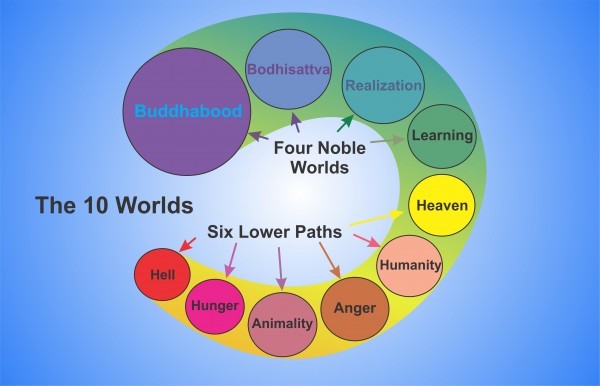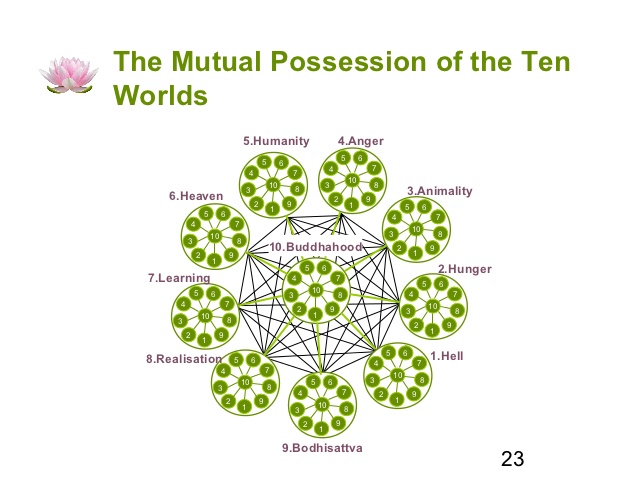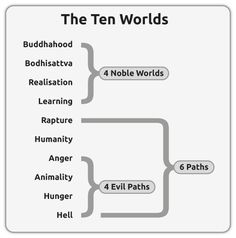(i) Buddhism Ten Worlds : Introduction
Buddhism Ten Worlds: These notes have been inspired from a video by Bill Donahue entitled “Buddha Ten Worlds of the Mind” .
In this article we will outline the ten worlds of man in relation to Buddhist Philosophy. Buddha says everyone has these ten worlds inside them, although different people and cultures emphasise some more than others. They are illustrated in the diagrams below which I found in an article by Margaret Blaine
They are the world of :
(i) The Six Lower Paths
- Hell = No way out where living is misery & despair. Destructive behaviour patterns
- Hunger = A person is at the mercy of their cravings for things such as food, drugs, money, pleasure, power, and recognition and is never satisfied
- Animal = “law of the jungle,” fearing stronger people and despising and preying on the weak. In survival instinctual mode all the time
- Anger = sees situations as a threat to their belief system. Dominant and descructive
- Tranquillity (Humanity) = does not have much momentum and energy. Passive and susceptible to outside influences
- Rapture (Heaven) = intense joy resulting from the fulfilment of desires, contentment all of which are short lived
(ii) The 4 Noble Paths:
- Learning = Seeking the truth through learning from others.
- Realisation = Finding truth through one’s own realisations rather than through others
- Bodhisattva =Service to others. Interested not only in one’s own enlightenment but that others should have it also
- Buddha Hood = Perfect happiness, freedom from karma.
(ii) Buddhism Ten Worlds : Interaction between Worlds
Buddha taught that all of these have a positive as well as a negative aspect. Without Hell we would never know what happiness is.
Buddha said when we start meditating our life can seem to be worse but this is only because we are more conscious of what has been around us.
Whichever state is dominant in us affects the other 9 worlds so there is an inter relationship between the worlds.
If the strongest aspect is anger for instance, but we also have Bodhisattva(service) as a strong element then our sense of giving will be clouded. Our anger may be directed towards individuals or the system.
He called this interaction MUTUAL POSSESSION:
Example 1: Hunger (desire) in a person dominated by tranquility
This person would long for something but never have the momentum to achieve it. An example could be someone who wants to change jobs but never does. This person keeps wishing and wishing for change for all of their live and nothing changes unless they go into higher realms of consciousness so they can break out of this pattern.
Example 2 : Hunger (desire) dominated by the Animal Nature
Compulsive shopping of things. Accumulating of material things.
Example 3: Tranquility dominated by the animal nature
This represents someone who has periods of aggressive behaviour interspersed with quiet times, so two modes at opposite ends of the spectrum.
Example 4 : Tranquility dominated by Hell = suffering in silence.
In all we have 100 worlds as each world has the other 9 inside of it.
Buddha looked at how we move from one world to the other so quickly
In rapture everything is wonderful and beautiful, but this world also contains the world of hell.
These world become dominant due to things happening in our childhood
So Buddha taught that for any moment we can change from one world into the next.
In learning & realisation also lies hell and so the capacity for suffering cannot be eradicated by knowledge it has to be through meditation
Question : When we are in hell where is rapture ? This brings in the 3 truths associated with Buddhism which we will discuss below.
(iii) Buddhism Ten Worlds & The Three Truths (Ke, Ku and Chu)
Buddha said all of these states are in a place of neither existence or non existence and is called a state of KU. This can be described as a place of latent potential or dormancy
For instance, with anger normally something causes us to be angry and this causes anger to come out of a state of KU.
This latent state of Ku explains why we are so changeable from one emotion to the next as we are constantly drawing states out of their latency into existence.
Jesus said “The Kingdom of God is within “
Similarly in nature, the trees wait for the spring to burst into bloom through the stimulus of sunlight and warmth.
From this, the world of hell also contains the world of Buddha Hood, and so no matter how much we are suffering or how old we are we can always connect to our highest self.
This is the analogy about Sarah, Abraham’s wife giving birth at the age of 90. It has nothing to do with a physical birth, but is talking about the spiritual life that can be born out of a barren situation & so here is always that potential
Buddha described the process of coming into life as KE
Mariana Soffer says:
“Ideas (ku) become realized as tangible changes or actions (ke). The nature (ku) of these actions will be influenced by Chu. Chu is the permeating life force of the universe; it may be compared to our essence, which in turn is shaped by our dominant life state.”#
Her article can be found by clicking here
(iv) Buddhism Ten Worlds: Conclusion
The Ten worlds can be summarized as shown in the above diagram. Buddha said if there is sediment at the bottom of your cup and the cup is stirred, then clean water becomes dirty whereas if there is no sediment and our emotional ‘waters’ gets stirred, then our water remains clean. Meditation helps to purge this ‘sediment’ from us and an understanding and recognition of the ten worlds of man is a useful starting point for allowing meditation to work on the different aspects of our nature.
Subsequent articles will discuss these ten worlds of man individually and in more detail.



